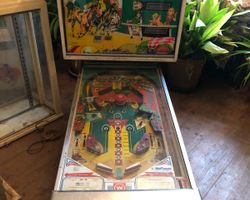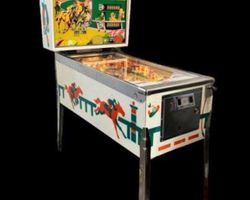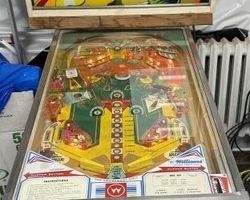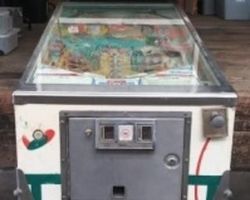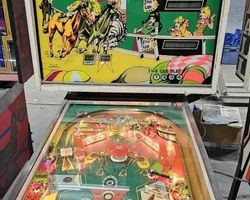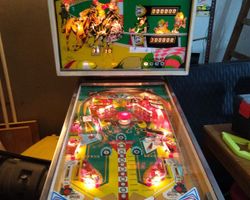Hot Tip
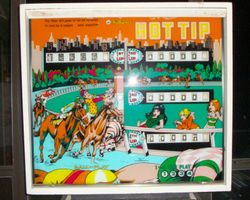
Average Prices: USD $200 to $700
Produced: June, 1977
Production Run: 1,300 units
Machine Type: Electro-mechanical
Players: 4
Design by: Tony Kraemer
Art by: Christian Marche
In the summer of 1977, as the pinball industry stood at the precipice of a major technological shift, Williams Electronics, Incorporated released 'Hot Tip'. This machine holds a unique position, existing both as one of the company's final electro-mechanical (EM) designs and simultaneously as one of its early solid-state (SS) offerings. The EM version, model number 474, represents a fascinating snapshot of pinball's evolution, capturing the essence of traditional EM gameplay while hinting at the digital future.
History and Background
Williams Electronics was a powerhouse in the coin-operated amusement industry, navigating the transition from purely mechanical devices to complex electronic games. June 27, 1977, marked the official start of production for the EM variant of Hot Tip. While its solid-state counterpart would eventually see a much larger production run, the EM version was produced in a confirmed quantity of 1,300 units, making it a relatively scarce title sought after by EM collectors.
The design credits belong to Tony Kraemer, while the distinctive artwork was penned by Christian Marche. The theme centers around horse racing, depicted with Marche's characteristic cartoonish and vibrant style. This theme provides a lively backdrop for the on-playfield action, featuring jockeys, horses, and humorous trackside scenes.
Production occurred in two main batches. An initial sample run of 288 units began shipping in September 1977. A larger production run of 1,012 units followed, commencing in November 1977 and concluding shipments by January 1978. Records indicate approximately 1,003 units were destined for the USA/Canada market, with 297 slated for export. The price to distributors was set at $970.00. The existence of both EM and SS versions of the same title, released concurrently, was unusual and reflects the transitional period. Williams was hedging its bets, catering to operators comfortable with established EM technology while simultaneously pushing forward with the new solid-state systems.
Signature Features and Design
Hot Tip EM embodies the quintessential electro-mechanical experience. Its most defining characteristic is its sound package: the classic trio of chimes, accompanied by the sharp rap of a knocker signaling awarded replays. These sounds are integral to the EM charm, providing satisfying auditory feedback synchronized with physical mechanisms like relays and score reels clicking over.
Christian Marche's artwork is a major draw. The backglass is a colorful spectacle of horse racing action, rendered with humor and exaggerated features typical of his style. Jockeys strain, horses gallop, and onlookers cheer, creating a sense of energy and fun. This aesthetic carries over to the playfield and cabinet art, ensuring a cohesive and engaging visual presentation.
Mechanically, the game packs numerous features into its standard-body cabinet. It utilizes two flippers, two slingshots, and a single pop bumper, standard components for the era. However, it also incorporates two banks of 3-drop targets, a captive ball, a spinning target, two kick-out holes, and standup targets. A notable design quirk is the unique tilt rollover located in the upper left lane – a small but potentially hazardous feature requiring careful nudging. The end-of-ball bonus accumulation system adds another layer to scoring strategy, rewarding consistent play.
Comparing the EM to its SS sibling reveals interesting scoring differences. Most significantly, many scoring features on the EM version award ten times the points of their SS counterparts (e.g., 1000 points vs 100 points). The spinning target is worth 1000 points when lit on the EM, compared to 100 points plus bonus advances on the SS. Inlanes score a hefty 5000 points on the EM versus 1000 on the SS. These adjustments reflect different design philosophies for balancing EM and SS scoring systems.
Playfield and Mechanics
The Hot Tip EM playfield is a well-integrated design that encourages target shooting and ball control. At the bottom are the two standard flippers and slingshots. Outlanes flank the flippers, with the left outlane often cited as being particularly dangerous, demanding attentive flipper skills to prevent drains. Inlanes return the ball safely to the flippers, scoring 5000 points.
Moving up the playfield, two banks of 3-drop targets command significant attention. Completing these banks is crucial for scoring and potentially lighting other features. Between these banks sits a captive ball, nestled behind a standup target. Hitting the captive ball requires precision and rewards players significantly. Further up, two standup targets offer additional scoring opportunities.
Central to the upper playfield is a single, powerful pop bumper, adding an element of chaotic rebound action. Adjacent to it is the spinning target; when lit, repeatedly hitting this target can rack up points quickly. Two kick-out holes are positioned on the upper sides of the playfield. Landing the ball in these holes scores points and ejects the ball back into play, often towards the pop bumper or drop targets.
The uppermost section features rollover lanes. The left lane incorporates the unique tilt rollover, a narrow lane where a rollover switch is placed precariously close to the 'tilt' mechanism's zone – triggering it ends the ball in play. Successfully navigating these top lanes contributes to the end-of-ball bonus.
The overall flow encourages shots towards the drop targets, captive ball, and spinner. The pop bumper and kick-out holes introduce unpredictability, keeping the player engaged. Marche's artwork covers the playfield, depicting the racetrack theme with clear visual cues for shots and scoring areas. The lighting is typical of EM machines, using incandescent bulbs to illuminate features and track progress, contributing to the warm, classic pinball ambiance.
Gameplay Dynamics
Playing Hot Tip EM is an exercise in classic pinball strategy focused on accuracy and controlled risk. The core objective is maximizing score through hitting targets, completing drop target banks, advancing the end-of-ball bonus, and collecting high-value shots like the lit spinner or captive ball.
The two 3-bank drop targets are primary objectives. Completing a bank often lights other features or awards significant points and bonus advances. Strategy involves deciding whether to pick off targets individually or attempt sweeps. The captive ball shot requires careful aim but offers substantial rewards. The spinning target, when lit, becomes a valuable point source, tempting players into repeated, potentially risky shots to keep it spinning.
The end-of-ball bonus accumulates throughout play by hitting specific targets or completing rollovers. Maximizing this bonus before draining is key to achieving high scores. Players must balance aggressive play to increase the bonus multiplier and value against the risk of losing the ball. The bonus is collected only when the ball drains.
Game modes, in the modern sense, don't exist on EM machines like Hot Tip. Instead, the dynamics revolve around lighting features and achieving specific shot combinations. For instance, completing the drop target banks might light the spinner or kick-out holes for higher values. Success relies on mastering ball control, understanding the playfield geometry, and making strategic decisions about which targets to prioritize. The relatively fast ball speed, coupled with the dangerous left outlane, means that games can be short and challenging, demanding focus from the player. The thrill comes from chaining shots, completing target banks, and hearing the satisfying symphony of chimes rack up points.
Reception and Legacy
Hot Tip EM is generally well-regarded within the pinball community, particularly among enthusiasts of electro-mechanical machines. Player feedback frequently highlights its engaging and fast-paced gameplay. The combination of drop targets, a spinner, and a captive ball provides varied objectives, keeping the action interesting. Many describe the game as addictive, praising the satisfying feel of hitting the targets and the classic EM soundscape.
Strengths often mentioned include the fun factor, the balanced layout offering multiple rewarding shots, and the appealing artwork by Christian Marche. Its status as one of Williams' last EM productions adds historical significance and collector appeal. The relatively lower production run compared to its SS counterpart enhances its desirability for those seeking less common EM titles.
Weaknesses are few but consistently noted. The primary criticism revolves around the left outlane drain, which some players find unforgiving, potentially leading to frustratingly short ball times. While the artwork is generally praised for its fun, cartoonish style, some find it simpler compared to later, more complex pinball art packages, though this is often framed as part of its vintage charm rather than a significant drawback.
The legacy of Hot Tip EM lies in its representation of the pinnacle of electro-mechanical design just as the industry was transitioning. It showcases Williams' ability to create a feature-rich and engaging EM experience. While its SS sibling paved the way for future electronic games, the EM version remains a beloved example of classic pinball fun, appreciated for its direct mechanical feedback, challenging layout, and vibrant theme. It stands as a testament to the enduring appeal of traditional pinball mechanics and aesthetics.
 Active Auctions
Active Auctions
 Auction Results
Auction Results
| Cost | Location | Date |
|---|---|---|
| EUR €586 |  Rheinland-Pfalz, Germany Rheinland-Pfalz, Germany |
27 March, 2025 |
| USD $625 |  Ohio, United States Ohio, United States |
16 November, 2024 |
| USD $185 |  Idaho, United States Idaho, United States |
31 July, 2024 |
| USD $280 |  Kansas, United States Kansas, United States |
18 March, 2024 |
| EUR €1,290 |  Bayern, Germany Bayern, Germany |
19 January, 2024 |
| USD $700 |  Illinois, United States Illinois, United States |
11 November, 2023 |
| EUR €910 |  Niedersachsen, Germany Niedersachsen, Germany |
29 December, 2021 |
| EUR €500 |  Hessen, Germany Hessen, Germany |
15 October, 2021 |
| EUR €1,050 |  Saarland, Germany Saarland, Germany |
23 June, 2021 |
| USD $3,400 |  Illinois, United States Illinois, United States |
09 December, 2020 |


Private Policy · Search Website · Contact Us
All trademarks and copyrighted materials remain property of their respective owners.
All other content copyright 2007 - 2025 Pinpedia.

